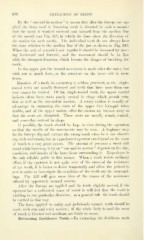Page 602 - My FlipBook
P. 602
600 EXTRACTION OF TEETH.
By the "out-aml-iii motion" is mcjint that after the forceps are ap-
plied the force used in loosening teeth is directed in such :i manner
that the tooth is worked outward and inward from tlic median line
of the mouth (see Fig. 519, in which the lines show the direction of
the motion for each tooth). The individual teeth do not always bear
the same relation to the median line of the jaw as shown in Fig. 519.
When the axis of a tooth is not regular it should be loosened by mov-
ing backward and forward, and the movement should be in line
with its strongest diameter, which lessens the danger of breaking the
tooth.
In the upper jaw the inward movement is made after the outer, but
with not so much force, as the structure on the inner side is more
dense.
Rotation of a tooth in extracting is seldom practiced, as the single-
rooted teeth are usually flattened and teeth that have more than one
root cannot be rotated. Of the single-rooted teeth, the upper central
incisors alone have roots nearly conical in shape which permit rota-
tion as well as the out-and-in motion. A rotary motion is usually of
advantage in extracting the roots of the upper first bicuspid when
double, and of the u})})er molars after the crowns are broken away so
that the roots are disunited. These roots are usually round, conical,
and somewhat curved in shape.
If possible, the tooth should be kept in view during the operation
so that the results of the movements may be seen. A beginner may
let the forceps slip and extract the w^rong tooth when he is not observ-
ing each movement, but an experienced operator can dej)end on his sense
of touch to a very great extent. The amount of pressure a tooth will
stand wliile loosening it by an " out-and-in motion " depends on the size,
condition, and density of the bony tissue surrounding it. Experience is
the only reliable guide in this matter. When a tooth resists ordinary
effort, if the operator is not quite sure of the cause of the resistance
of the tooth, it is better to desist temporarily and allow the patient to
rest in order to investigate the condition of the tooth and its surround-
ings. Fig. 530 will give some idea of the causes of the resistance
offered by apparently normal crowns.
After the forceps are applied and the tooth slightly moved, if the
operator has a cultivated sense of touch he will feel that the tooth is
yielding in one particular direction ; as a general rule the tooth should
be carried in that way.
The force applied to safely and judiciously extract teeth should be
made with arm and wrist motion ; if the whole body is used the sense
of touch is blunted and accidents are liable to occur.
Extracting Deciduous Teeth.—In extracting the deciduous teeth


